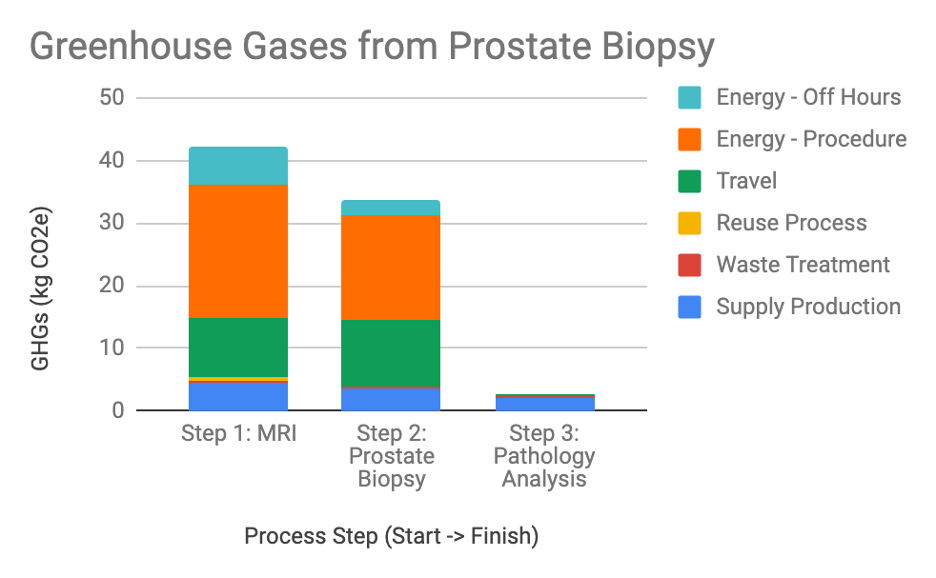Back
Poster, Podium & Video Sessions
Moderated Poster
MP30: Global Health/Humanitarian
MP30-14: Environmental Impact of Transrectal Ultrasound Guided Prostate Biopsy
Saturday, May 14, 2022
1:00 PM – 2:15 PM
Location: Room 222
Michael Leapman*, NEW HAVEN, CT, Cassandra Thiel, New York, NY, Ilyssa Gordon, Cleveland, OH, Adam Nolte, Miami, FL, Aaron Perecman, Burlington, MA, Michael Overcash, Wichita, KS, Jodi Sherman, New Haven, CT
- ML
Michael Leapman, MD
Yale University School of Medicine
Poster Presenter(s)
Introduction: Healthcare is a major contributor to global pollution. Reducing the over-use of clinical care is one solution to lowering environmental emissions and improving care value. We aimed to estimate the environmental impact of transrectal ultrasound (TRUS) prostate biopsy, a procedure that is commonly performed in excess of recommended guidelines based on patient age or life-expectancy.
Methods: We performed a cradle-to-grave life cycle assessment (LCA) to estimate environmental emissions associated with a single TRUS biopsy. Data included materials and energy inventory, as well as patient and staff travel across 3 process-steps: a pre-biopsy prostate magnetic resonance imaging (MRI), TRUS biopsy, and pathology laboratory processing. We performed sensitivity analyses to assess contributions from waste, travel, and energy use. The primary endpoint was greenhouse gas (GHG) emissions (CO2 equivalents, CO2e), calculated using LCA tools Ecoinvent (a database of emissions) and the US Environmental Protection Agency’s TRACI 2.1 v1.04 (Tool for Reduction and Assessment of Chemicals and Other Environmental Impacts). We estimated the potential environmental impacts associated with reductions in the annual number of biopsies performed.
Results: A single prostate biopsy procedure involving prostate MRI emits an estimated 78.7 kg CO2e. Overall, energy was the largest contributor to CO2 emissions, with an estimated 46.8kg CO2e, 59.5% of the procedural total. Staff travel contributed 20.0kg CO2e (25.4%), followed by supply production (10.2kg CO2e, 13%). Integration of a prostate MRI process step contributed an estimated 42.3kg CO2e, 53.8% of the total emissions. Reduction of prostate biopsy (per 100,000 procedures) would avoid the equivalent of 7.87x106 kg CO2e , the equivalent of 190,778,876 miles driven by an average passenger vehicle.
Conclusions: Although prostate biopsy is a small-scale procedure, it contributes a calculable environmental footprint. Reducing the number of prostate biopsies performed, in line with best clinical practice, would also result in significant reductions in health care pollution.
Source of Funding: None

Methods: We performed a cradle-to-grave life cycle assessment (LCA) to estimate environmental emissions associated with a single TRUS biopsy. Data included materials and energy inventory, as well as patient and staff travel across 3 process-steps: a pre-biopsy prostate magnetic resonance imaging (MRI), TRUS biopsy, and pathology laboratory processing. We performed sensitivity analyses to assess contributions from waste, travel, and energy use. The primary endpoint was greenhouse gas (GHG) emissions (CO2 equivalents, CO2e), calculated using LCA tools Ecoinvent (a database of emissions) and the US Environmental Protection Agency’s TRACI 2.1 v1.04 (Tool for Reduction and Assessment of Chemicals and Other Environmental Impacts). We estimated the potential environmental impacts associated with reductions in the annual number of biopsies performed.
Results: A single prostate biopsy procedure involving prostate MRI emits an estimated 78.7 kg CO2e. Overall, energy was the largest contributor to CO2 emissions, with an estimated 46.8kg CO2e, 59.5% of the procedural total. Staff travel contributed 20.0kg CO2e (25.4%), followed by supply production (10.2kg CO2e, 13%). Integration of a prostate MRI process step contributed an estimated 42.3kg CO2e, 53.8% of the total emissions. Reduction of prostate biopsy (per 100,000 procedures) would avoid the equivalent of 7.87x106 kg CO2e , the equivalent of 190,778,876 miles driven by an average passenger vehicle.
Conclusions: Although prostate biopsy is a small-scale procedure, it contributes a calculable environmental footprint. Reducing the number of prostate biopsies performed, in line with best clinical practice, would also result in significant reductions in health care pollution.
Source of Funding: None


.jpg)
.jpg)